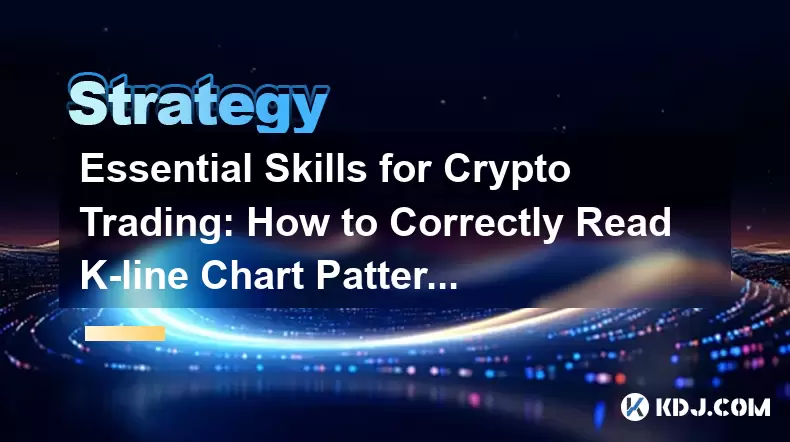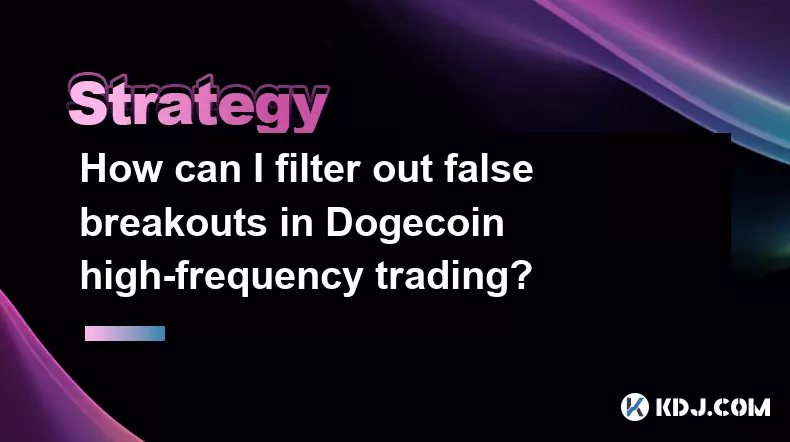-
 bitcoin
bitcoin $114779.865156 USD
2.30% -
 ethereum
ethereum $4226.519789 USD
2.39% -
 tether
tether $1.000545 USD
0.04% -
 xrp
xrp $2.890223 USD
0.92% -
 bnb
bnb $1030.029301 USD
2.95% -
 solana
solana $212.824944 USD
1.69% -
 usd-coin
usd-coin $0.999757 USD
0.01% -
 dogecoin
dogecoin $0.234961 USD
-0.27% -
 tron
tron $0.337174 USD
0.42% -
 cardano
cardano $0.804783 USD
0.09% -
 hyperliquid
hyperliquid $45.748770 USD
-2.85% -
 chainlink
chainlink $21.699170 USD
0.82% -
 ethena-usde
ethena-usde $1.001452 USD
0.08% -
 avalanche
avalanche $30.237800 USD
1.14% -
 stellar
stellar $0.372604 USD
1.52%
Essential Skills for Crypto Trading: How to Correctly Read K-line Chart Patterns and Signals
Understanding K-line charts is essential for crypto trading, as they reveal price trends and market sentiment through candlestick patterns and volume indicators.
Jun 19, 2025 at 06:07 pm

Understanding the Basics of K-line Charts
K-line charts, also known as candlestick charts, are fundamental tools used in technical analysis for cryptocurrency trading. Each K-line represents a specific time interval, such as one minute, five minutes, one hour, or even one day, depending on the chart setting. The body of the candle shows the opening and closing prices during that period, while the upper and lower wicks (or shadows) indicate the highest and lowest prices reached.
The color of the candle is crucial: green candles signify that the closing price was higher than the opening price (bullish), while red candles indicate the opposite (bearish). Traders must understand how to interpret these visual cues quickly and accurately to make informed decisions in real-time market conditions.
Key Takeaway: Accurate interpretation of K-lines starts with recognizing the significance of candle colors, body size, and wick length.
Identifying Common K-line Patterns
Several recurring K-line patterns offer insight into potential price movements. These include:
- Bullish Engulfing Pattern: A small red candle followed by a larger green candle that completely engulfs the previous candle.
- Bearish Engulfing Pattern: The reverse of the bullish pattern, indicating a potential downward trend.
- Hammer: A candle with a long lower wick and small body at the top, often signaling a reversal from a downtrend.
- Shooting Star: Similar to the hammer but appears at the end of an uptrend, suggesting a possible bearish reversal.
- Doji: A candle where the opening and closing prices are nearly equal, showing indecision in the market.
Each of these patterns provides valuable information about market sentiment and momentum. For instance, a hammer appearing after a series of red candles might suggest that buyers are stepping in and pushing prices up, potentially reversing the downtrend.
Important Note: Always confirm K-line patterns with volume indicators or other technical tools before making a trade decision.
Reading Candlestick Signals in Crypto Markets
Cryptocurrency markets operate 24/7, which makes candlestick signals more dynamic compared to traditional stock markets. Here's how traders can effectively use them:
- Look for reversal patterns when the price reaches significant support or resistance levels.
- Pay attention to volume spikes accompanying certain candlesticks, as they add credibility to the signal.
- Combine K-line signals with moving averages or RSI (Relative Strength Index) to filter false signals.
For example, if a morning star pattern forms near a key support level and is accompanied by increasing volume, it could be a strong buy signal. Conversely, a dark cloud cover forming at a resistance zone may suggest a sell-off is imminent.
Critical Tip: Never rely solely on K-line signals—always cross-reference with other technical indicators.
Practical Steps to Analyze K-line Charts
Here’s a step-by-step guide to analyzing K-line charts effectively:
- Choose the appropriate timeframe based on your trading strategy (e.g., day traders may use 15-minute or 1-hour charts).
- Zoom out to identify broader trends (support/resistance levels, moving average crossovers).
- Look for recognizable candlestick patterns within those trends.
- Check the volume beneath each candle to assess the strength of the move.
- Use Fibonacci retracement levels or Bollinger Bands to confirm potential entry and exit points.
This methodical approach ensures that you're not just reacting emotionally to price swings but instead making calculated, data-driven decisions.
Pro Insight: Consistency in applying this process builds discipline and improves long-term trading performance.
Avoiding Common Mistakes When Reading K-lines
Many novice traders fall into traps when interpreting K-line charts. Some common mistakes include:
- Overtrading based on isolated candlestick patterns without confirmation.
- Ignoring context—such as overall market direction or macroeconomic factors.
- Failing to set stop-loss orders, leading to large losses when reversals don’t materialize.
- Misinterpreting candle formations due to lack of experience or rushed analysis.
To avoid these pitfalls, maintain a trading journal where you document every trade, including why you entered and exited, what signals you relied on, and whether the outcome matched your expectations.
Essential Advice: Discipline and continuous learning are vital to mastering K-line analysis.
Frequently Asked Questions
Q: Can I rely solely on K-line patterns for trading decisions?A: While K-line patterns are powerful, they should be used in conjunction with other tools like volume, moving averages, and RSI to increase accuracy and reduce risk.
Q: Which timeframe is best for reading K-line charts in crypto trading?A: There's no single 'best' timeframe—it depends on your trading style. Day traders typically use 1-minute to 15-minute charts, while swing traders prefer hourly or daily charts.
Q: How do I differentiate between a reliable K-line signal and a fake one?A: Look for confluence with other indicators, check for volume validation, and ensure the pattern occurs at a meaningful support or resistance level.
Q: Are K-line patterns applicable across all cryptocurrencies?A: Yes, K-line patterns work universally across all assets, including Bitcoin, Ethereum, altcoins, and fiat currencies. However, market liquidity and volatility can affect their reliability.
Disclaimer:info@kdj.com
The information provided is not trading advice. kdj.com does not assume any responsibility for any investments made based on the information provided in this article. Cryptocurrencies are highly volatile and it is highly recommended that you invest with caution after thorough research!
If you believe that the content used on this website infringes your copyright, please contact us immediately (info@kdj.com) and we will delete it promptly.
- Altcoins Primed for 100x Gains: Cryptocurrencies to Watch
- 2025-09-30 22:45:16
- Debut Auction & XRP ETF Watch: October 18th Auction Set, Crypto's Big Day?
- 2025-09-30 22:45:16
- Navigating Solana Wallets: Your Guide to Secure Crypto in 2025
- 2025-09-30 22:50:11
- BlockchainFX, Crypto & Hyperliquid: Decoding the Future of DeFi in 2025
- 2025-09-30 22:25:13
- Visa's Stablecoin Payout Pilot: Revolutionizing Cross-Border Payments
- 2025-09-30 22:25:13
- Crypto Launchpads: Revolutionizing Blockchain Fundraising for 2025 and Beyond
- 2025-09-30 22:30:13
Related knowledge

Practical parameter settings for a Bitcoin multi-timeframe moving average system
Sep 18,2025 at 10:54pm
Optimizing Timeframe Combinations for Bitcoin Trading1. Selecting appropriate timeframes is crucial when building a multi-timeframe moving average sys...

How can I filter out false breakouts in Dogecoin high-frequency trading?
Sep 22,2025 at 01:00am
Understanding False Breakouts in Dogecoin Trading1. A false breakout occurs when Dogecoin's price appears to move beyond a defined support or resistan...

Techniques for identifying tops and bottoms in the Bitcoin on-chain NVT model
Sep 20,2025 at 07:54pm
Understanding the NVT Model in Bitcoin Analysis1. The Network Value to Transactions (NVT) ratio is often described as the 'P/E ratio' of the cryptocur...

What does the surge in open interest in Bitcoincoin futures mean?
Sep 20,2025 at 11:18pm
Understanding the Surge in Dogecoin Futures Open Interest1. A surge in open interest within Dogecoin futures indicates a growing number of active cont...

How can I use the Ethereum USDT premium to gauge market sentiment?
Sep 18,2025 at 11:55pm
Understanding the Ethereum USDT Premium1. The Ethereum USDT premium refers to the price difference between USDT (Tether) traded on Ethereum-based plat...

What should I do if Ethereum staking yields decline?
Sep 20,2025 at 06:18am
Understanding the Causes Behind Declining Ethereum Staking Yields1. The Ethereum network transitioned to a proof-of-stake consensus mechanism with the...

Practical parameter settings for a Bitcoin multi-timeframe moving average system
Sep 18,2025 at 10:54pm
Optimizing Timeframe Combinations for Bitcoin Trading1. Selecting appropriate timeframes is crucial when building a multi-timeframe moving average sys...

How can I filter out false breakouts in Dogecoin high-frequency trading?
Sep 22,2025 at 01:00am
Understanding False Breakouts in Dogecoin Trading1. A false breakout occurs when Dogecoin's price appears to move beyond a defined support or resistan...

Techniques for identifying tops and bottoms in the Bitcoin on-chain NVT model
Sep 20,2025 at 07:54pm
Understanding the NVT Model in Bitcoin Analysis1. The Network Value to Transactions (NVT) ratio is often described as the 'P/E ratio' of the cryptocur...

What does the surge in open interest in Bitcoincoin futures mean?
Sep 20,2025 at 11:18pm
Understanding the Surge in Dogecoin Futures Open Interest1. A surge in open interest within Dogecoin futures indicates a growing number of active cont...

How can I use the Ethereum USDT premium to gauge market sentiment?
Sep 18,2025 at 11:55pm
Understanding the Ethereum USDT Premium1. The Ethereum USDT premium refers to the price difference between USDT (Tether) traded on Ethereum-based plat...

What should I do if Ethereum staking yields decline?
Sep 20,2025 at 06:18am
Understanding the Causes Behind Declining Ethereum Staking Yields1. The Ethereum network transitioned to a proof-of-stake consensus mechanism with the...
See all articles










































































